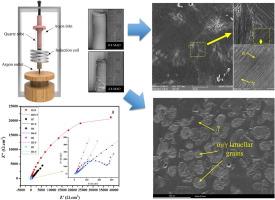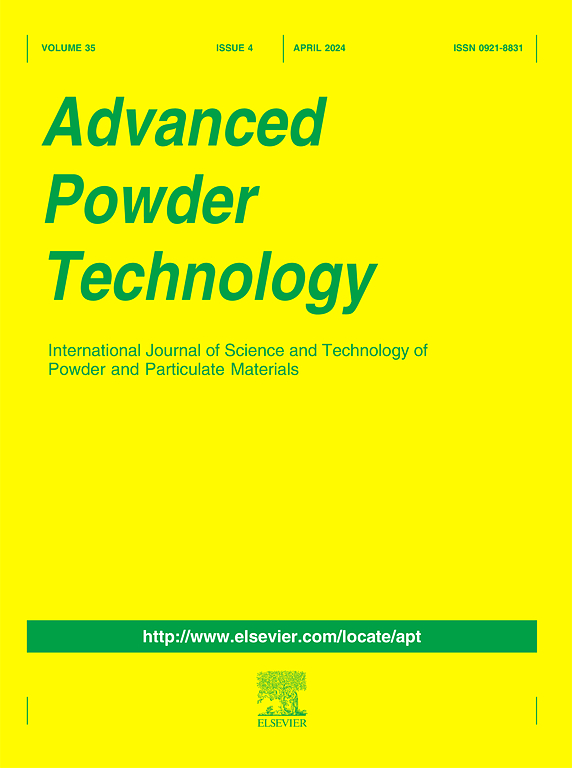Investigating the effect of mechanical activation duration (MAD) on the microstructure and corrosion behavior of TiAl intermetallic compounds
IF 4.2
2区 工程技术
Q2 ENGINEERING, CHEMICAL
引用次数: 0
Abstract
An innovative method for fabrication and investigating the effect of mechanical activation duration (MAD) on the properties of TiAl alloys was developed. The study employs an efficient implementation of combustion reactions in a compressed, mechanically activated mixture of titanium and aluminum, leading to the synthesis of titanium aluminide (TiAl). The induction-activated method initiates an exothermic reaction between Ti and Al, facilitating simultaneous preheating and ignition under an argon gas atmosphere. The accomplishment of the synthesis process lasted very short times, and the products were characterized using X-ray diffraction (XRD), energy dispersive X-ray (EDX), scanning electron microscopy (SEM), and electrochemical impedance spectroscopy (EIS) techniques. The investigation focuses on samples with MAD durations ranging from 1 to 10 h, revealing that higher MADs (4 to 10 h) result in an innovative microstructure with α2 (Ti3Al)/γ (TiAl) round-shape lamellar grains embedded in the γ (TiAl) matrix. This microstructure enhances the toughness of TiAl alloys while maintaining comparable hardness. The study indicates that increasing MAD from 1 to 10 h improves reaction kinetics, leading to a rise in reaction front velocity from 3.95 to 5.02 mm s−1 and a reduction in α2 (Ti3Al)/γ (TiAl) round-shape lamellar grain size from 215.804 to 172.709 μm in a more homogeneous arrangement. Furthermore, corrosion behavior analysis for samples with 1 and 10 h MAD reveals an increase in the resistance of the oxide layer (Rf) value from 702.9 to 43111 Ω.cm2 and the charge transfer resistance (Rct) value from 41.84 to 18520 Ω.cm2.

研究机械活化持续时间 (MAD) 对 TiAl 金属间化合物微观结构和腐蚀行为的影响
我们开发了一种创新方法,用于制造和研究机械活化持续时间(MAD)对钛铝合金性能的影响。该研究采用了一种在钛和铝的压缩机械活化混合物中有效实施燃烧反应的方法,从而合成了铝化钛(TiAl)。感应活化法可引发钛和铝之间的放热反应,在氩气环境下同时进行预热和点火。合成过程持续的时间很短,使用 X 射线衍射 (XRD)、能量色散 X 射线 (EDX)、扫描电子显微镜 (SEM) 和电化学阻抗光谱 (EIS) 技术对产品进行了表征。研究重点是 MAD 持续时间为 1 到 10 小时的样品,结果表明,较高的 MAD(4 到 10 小时)会产生一种创新的微观结构,α2(Ti3Al)/γ(TiAl)圆形片状晶粒嵌入γ(TiAl)基体中。这种微观结构提高了 TiAl 合金的韧性,同时保持了相当的硬度。研究表明,将 MAD 从 1 小时增加到 10 小时可改善反应动力学,使反应前沿速度从 3.95 mm s-1 上升到 5.02 mm s-1,并使 α2 (Ti3Al)/γ (TiAl) 圆形片状晶粒大小从 215.804 μm 减小到 172.709 μm,排列更加均匀。此外,对 MAD 为 1 小时和 10 小时的样品进行的腐蚀行为分析表明,氧化层电阻(Rf)值从 702.9 Ω.cm2 增加到 43111 Ω.cm2,电荷转移电阻(Rct)值从 41.84 Ω.cm2 增加到 18520 Ω.cm2。
本文章由计算机程序翻译,如有差异,请以英文原文为准。
求助全文
约1分钟内获得全文
求助全文
来源期刊

Advanced Powder Technology
工程技术-工程:化工
CiteScore
9.50
自引率
7.70%
发文量
424
审稿时长
55 days
期刊介绍:
The aim of Advanced Powder Technology is to meet the demand for an international journal that integrates all aspects of science and technology research on powder and particulate materials. The journal fulfills this purpose by publishing original research papers, rapid communications, reviews, and translated articles by prominent researchers worldwide.
The editorial work of Advanced Powder Technology, which was founded as the International Journal of the Society of Powder Technology, Japan, is now shared by distinguished board members, who operate in a unique framework designed to respond to the increasing global demand for articles on not only powder and particles, but also on various materials produced from them.
Advanced Powder Technology covers various areas, but a discussion of powder and particles is required in articles. Topics include: Production of powder and particulate materials in gases and liquids(nanoparticles, fine ceramics, pharmaceuticals, novel functional materials, etc.); Aerosol and colloidal processing; Powder and particle characterization; Dynamics and phenomena; Calculation and simulation (CFD, DEM, Monte Carlo method, population balance, etc.); Measurement and control of powder processes; Particle modification; Comminution; Powder handling and operations (storage, transport, granulation, separation, fluidization, etc.)
 求助内容:
求助内容: 应助结果提醒方式:
应助结果提醒方式:


